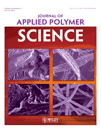Reinforcement of soy polyol-based rigid polyurethane foams by cellulose microfibers and nanoclays
Abstract
Water-blown rigid polyurethane foams from soy-based polyol were prepared and their structure–property correlations investigated. Cellulose microfibers and nanoclays were added to the formulations to investigate their effect on morphology, mechanical, and thermal properties of polyurethane foams. Physical properties of foams, including density and compressive strength, were determined. The cellular morphologies of foams were analyzed by SEM and X-ray micro-CT and revealed that incorporation of microfibers and nanoclays into foam altered the cellular structure of the foams. Average cell size decreased, cell size distribution narrowed and number fractions of small cells increased with the incorporation of microfibers and nanoclays into the foam, thereby altering the foam mechanical properties. The morphology and properties of nanoclay reinforced polyurethane foams were also found to be dependent on the functional groups of the organic modifiers. Results showed that the compressive strengths of rigid foams were increased by addition of cellulose microfibers or nanoclays into the foams. Thermogravimetric analysis (TGA) was used to characterize the thermal decomposition properties of the foams. The thermal decomposition behavior of all soy-based polyurethane foams was a three-step process and while the addition of cellulose microfibers delayed the onset of degradation, incorporation of nanoclays seemed to have no significant influence on the thermal degradation properties of the foams as compared to the foams without reinforcements. © 2011 Wiley Periodicals, Inc. J Appl Polym Sci, 2011




